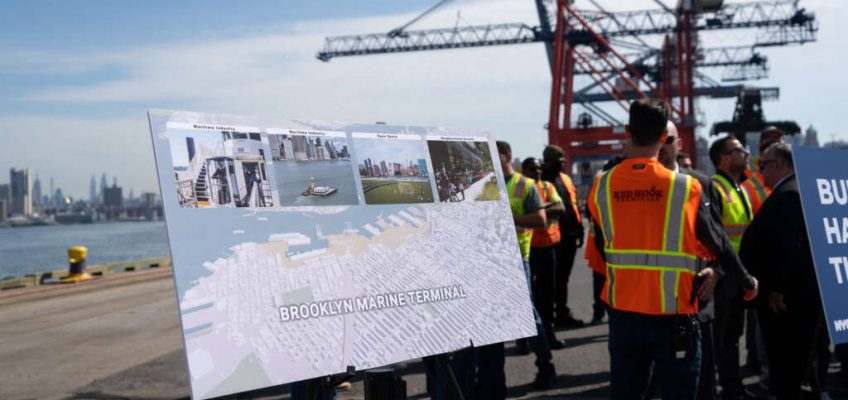“The problem with EDC’s plan is that most Red Hook residents were never given an opportunity to have in-depth discussions, backed by independent technical research and assistance, about the future of the community.”
City and state officials announcing plans to redevelop Red Hook’s Brooklyn Marine Terminal last year. (Caroline Rubinstein-Willis/Mayoral Photography Office)
The City’s Economic Development Corporation—an agency under Mayor Eric Adams’ office—recently released a plan to redevelop Brooklyn’s Red Hook waterfront with majority market-rate housing while purportedly stabilizing the limited port facilities that are left there. That plan has met with a good deal of skepticism and outright opposition from Red Hook residents and some key elected officials.
The problem with EDC’s plan is that most Red Hook residents were never given an opportunity to have in-depth discussions, backed by independent technical research and assistance, about the future of the community. As a result, the mayor’s plan, if implemented, may very well inflate economic and racial inequalities, stimulate more upscale development and displace more people than it is able to provide housing for.
I know this because in 1992, over two decades ago, I was a senior planner with the Brooklyn Office of the City Planning Department and main advisor to Community Board 6 as it completed the neighborhood’s first community plan, “Red Hook: A Plan for Community Regeneration,” one of the first community plans that went on to be approved by the City Planning Commission. I worked closely for almost two years with Community Board 6 and its appointed subcommittee that included residents, nonprofits and business representatives.
Among the many neighborhood conditions that residents then saw as problematic were lack of public access to the waterfront, and the racial and class divisions partially corresponding to the divides between public housing and other renters and homeowners. It is clear that these divides still exist.
It is also clear to me that EDC’s plan would only exacerbate these historic divisions. First of all, it would create a new segregated enclave of mostly upscale private housing on the waterfront. Secondly, it would spur additional speculative land value increases that will spark demand for even more private housing, displace tenants, and further isolate other commercial waterfront uses and public housing.
Third, it proposes to encourage limited waterfront commercial development without solid solutions to the growing problems of last-mile deliveries, traffic congestion, waste management, and access to public transit.
I strongly urge residents, business owners, Community Board 6, and all elected officials, including those who will soon take office, to stop EDC’s rush towards approval of the plan.
The next city administration should make a fresh start in the spirit of the ground-breaking 1994 community plan. That plan took time—two years—and it was worth it! I am convinced that genuine community engagement is capable of yielding creative new ideas and plans across generations that lead to transformative changes.
Tom Angotti, Ph.D., us an urban planning and policy development professor emeritus at CUNY’s Hunter College and The Graduate Center, and an adjunct professor at Parsons/The New School.
The post Opinion: EDC’s Plan for Red Hook is a Boon for Developers appeared first on City Limits.


Leave a Reply